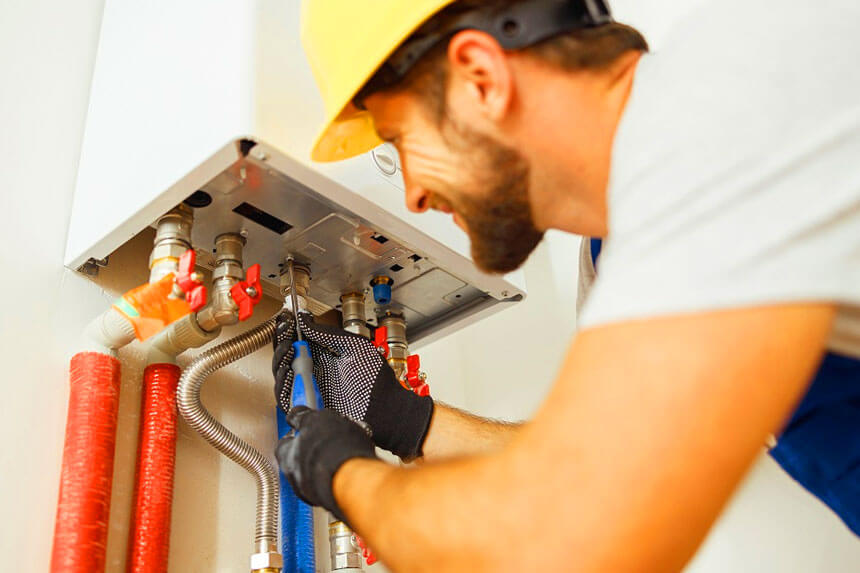Water heater inspections should happen every two months for basic checks and annually for professional service. Regular inspections prevent unexpected breakdowns, extend your unit’s life, and keep your family safe from dangerous gas leaks or carbon monoxide exposure. With new DOE energy efficiency standards taking effect in 2029, understanding proper appliance maintenance has become more crucial than ever.
Water Heater Inspections
Hot water heater maintenance starts with understanding what an annual assessment covers. You can handle basic visual checks yourself, but professionals test safety systems and perform complex tasks. The term “inspection” derives from the Latin “inspectio,” meaning “to look into,” which perfectly describes this essential home safety assessment.
Most homeowners can spot obvious problems like leaks or strange noises during simple monthly walks around their unit. You should plan on inspecting your water heater every two months to avoid any major plumbing problems, such as leaks or burst pipes. Professional technicians bring specialized tools to examine pressure valves, check gas connections, and flush tanks safely. They also know local building codes and can spot safety violations you might miss.
Professional inspections cost between $100-200 but prevent thousands in damage from burst tanks or gas leaks. The investment pays for itself when you catch problems early instead of dealing with emergency repairs or full replacements. Modern heating system evaluation has become more sophisticated with smart technology integration.
How Often to Inspect—and Why
As a general rule, it’s recommended to have your water heater inspected at least once a year by a professional plumber. Your DIY inspection checklist should run every two to three months for basic safety checks. This routine inspection schedule prevents the costly consequences of maintenance neglect.
Sediment buildup changes your timeline significantly. In areas with hard water or water with high mineral content, sediment buildup can occur more quickly. In such cases, more frequent inspections, perhaps every six to nine months, may be necessary to prevent sediment accumulation and maintain efficiency. Hard water areas need flushing every six months instead of annually. Your water quality determines how often you need drain and flush services.
Age matters too. Older water heaters, especially those nearing the end of their expected lifespan (usually around 10 to15 years for tank-style heaters), should be inspected more frequently, perhaps every six months, to catch any signs of wear or potential issues. Units over ten years old need closer attention because failure rates increase significantly. Watch for efficiency drops and higher energy bills that signal declining performance.
The new standards apply to both gas-fired and electric water heaters, with different requirements based on tank size and fuel type. Starting May 6, 2029, new energy efficiency regulations will affect replacement units, making preventive care even more important for extending your current system’s life.
DIY Inspection Checklist—with Context
Your monthly checks take just minutes but catch major problems early. Check your faucets for a supply of hot water. Check the color of your water. Listen for banging or unusual noises. Check your faucets and shower for decreased hot water pressure. This tank examination requires no special tools.
Start with water quality tests at your faucets. Rusty or discolored water signals anode rod inspection needs. The anode rod prevents tank corrosion, and when it fails, your water turns brown or develops a metallic taste. Strange smells like rotten eggs indicate bacteria growth in the tank, especially if you keep temperatures below 120 degrees.
Look around the base for water puddles or moisture. Check for scorch marks on the base of the water heater. Check for the proper ventilation of a gas water heater. Confirm the drain pan is under the water heater and empty it if necessary. Scorch marks near gas units signal dangerous backdrafting that can release carbon monoxide into your home. Clear any storage items or debris from around the unit to maintain proper airflow.
Listen for unusual sounds during operation. Hot water heater noises are usually caused by sediment build-up on the bottom of the tank. When this happens, it can cause the unit to overheat and eventually fail. Popping or banging noises mean sediment layers are interfering with heating elements. These sounds warn you that energy efficiency is dropping and failure risks are rising.
Smart technology now makes appliance evaluation easier. With a smart water heater, users can manage and monitor their water heating system from any location using their smartphone or home automation system. These systems can alert you to problems before they become major issues.
Professional Inspection Steps
Licensed technicians perform safety tests you cannot do yourself. A professional plumber will typically perform the following tasks during a water heater inspection: Visual inspection: The plumber will check for signs of corrosion, leaks, or damage to the exterior of the water heater, as well as inspect the surrounding area for any potential hazards. This comprehensive building systems review ensures safety compliance.
TPR valve testing requires special tools and knowledge. Pressure relief valve test: The plumber will test the pressure relief valve, a critical safety device that prevents the buildup of excessive pressure within the water heater. This valve testing prevents explosions if pressure builds too high. Only professionals should test it because improper handling can damage the valve or create safety hazards.
Gas line inspections check for dangerous leaks. Check the fuel gas piping to see if the gas piping holds pressure. (Leak test per 2015 IFGC section 406.) Check the gas pressure regulator to verify the supplied gas pressure is within the gas pressure range on the appliance gas regulator. Technicians use specialized equipment to detect even tiny gas leaks that could cause fires or explosions.
Professional inspection frequency includes tank flushing and water heater troubleshooting for complex issues. Tank flushing: The plumber may flush the tank to remove any sediment buildup, which can negatively impact the efficiency and lifespan of your water heater. They also inspect internal components like heating elements, thermostats, and electrical connections that require technical expertise to evaluate safely.
Inspection Permits
Building inspectors may require permits for water heater work. The simple answer is the permit is required so that an inspection can be done to make sure the water heater is installed properly, and that it does not create a hazard to the building occupants. Check local building codes before scheduling professional services or replacements. This efficiency verification process protects public safety.
Differences by Heater Type to Inspect
Tankless water heater checks focus on different components than traditional tanks. Check for proper venting of the appliance. Immediate action is critical if the inspector detects gas odors. These systems require specialized electric unit assessment techniques.
Tankless and Smart Units
The low exhaust gas temperatures allow the use of PVC exhaust pipes, including schedule 40 PVC, CPVC, polypropylene (rigid and flexible), and stainless steel venting. Tankless venting systems require different inspection approaches than traditional flue pipes. Check intake and exhaust connections for proper sealing and clearances.
Tankless heater units need regular filter cleaning every few months. Hard water areas may need monthly filter attention. A scale-resistant heat exchanger helps to prevent mineral buildup and acts sort of like a self-cleaning feature. Heat exchangers require professional descaling annually to prevent mineral buildup that reduces efficiency and shortens equipment life.
Smart water heaters add new dimensions to inspections. Smart water heaters come with the ability to preset heating cycles. You can program your water heater to only heat water during off-peak hours. These systems offer thermal expansion monitoring capabilities and diagnostic tools that alert homeowners to potential issues.
Tank Units
Traditional storage tanks focus on sediment issues and structural integrity. Gas tank inspection emphasizes temperature control settings, flue connections, and storage tank condition. Look for bulging sides, rust spots, or corrosion around fittings that signal tank failure approaching. This heating unit evaluation requires understanding both mechanical and safety aspects.
Common Signs of Trouble and What to Do
The most obvious sign of water heater failure is a lack of hot water supply. When hot water stops flowing or temperatures become inconsistent, your unit needs immediate attention. This represents the opposite of inspection avoidance—immediate action is required.
Visible leak problems require fast action. If you see any pooling water beneath your tank, corrosion is leading to fractures and cracks in the tank or your TPR valve has a serious leak. Clear signs of leaks from your tank calls for immediate action and replacement of the water heater. Turn off water supply and power immediately, then call a plumbing contractor.
Strange sounds mean different problems. These sounds may include popping, banging, or even rumbling. Hot water heater noises are usually caused by sediment build-up on the bottom of the tank. Popping sounds signal sediment layers interfering with heating. Banging indicates loose components or pressure issues requiring professional diagnosis.
Water quality changes warn of internal damage. If you start to notice that your hot water is yellow, discolored or rusty, this is a sign that the anode rod in your water heater tank is beginning to fail. Rusty water means corrosion protection has failed and tank replacement may be needed soon.
Energy bill spikes without usage changes indicate efficiency loss. A sudden spike in your utility bills could be linked to an inefficient water heater. As appliances age, they lose efficiency, especially if there’s a sediment buildup at the bottom of the tank. Schedule professional service when bills increase unexpectedly.
Smart Tips to Boost Inspection Value
Document everything with photos and maintenance logs. Take pictures of data plates, settings, and any problems you find. Date-stamped photos help track changes over time and provide valuable information for technicians. This proactive maintenance approach supports your home maintenance program.
Install safety devices around your water heater. To prevent carbon monoxide exposure from a water heater, make sure it is properly ventilated. Carbon monoxide detectors near gas units provide early warning of dangerous fumes. Temperature limiting devices prevent scalding accidents. These additions support combustion air assessment requirements.
Insulate tanks and pipes for better energy efficiency. Thermal wraps reduce heat loss and lower operating costs. Pipe insulation prevents condensation and maintains water temperatures longer. These simple additions often pay for themselves within a year through energy savings.
Modern smart technology enhances inspection capabilities. Machine learning algorithms that adapt to household usage patterns help optimize performance and detect problems early. Smart Life tracking technology. This is an integrated feature that helps to track the overall usage of your water heater and provides you with an estimated remaining lifespan.
Keep maintenance records and warranty paperwork organized. Track inspection dates, repairs, and part replacements. This documentation helps technicians diagnose problems faster and may be required for warranty claims. Well-maintained units last years longer than neglected ones.
Set calendar reminders for regular checks. Monthly visual inspections take just minutes but catch problems early. Annual professional service prevents most emergency failures. Consistent attention keeps your family comfortable and your home safe from water damage.
Bottom Line: Regular water heater inspections prevent expensive surprises and keep your family safe. Monthly DIY checks catch obvious problems early, while annual professional service ensures proper operation and safety compliance. With new DOE efficiency standards taking effect in 2029, proper inspection and maintenance become even more critical for maximizing your current system’s lifespan and preparing for future upgrades. The small investment in routine maintenance saves thousands in emergency repairs and extends your unit’s lifespan significantly.














